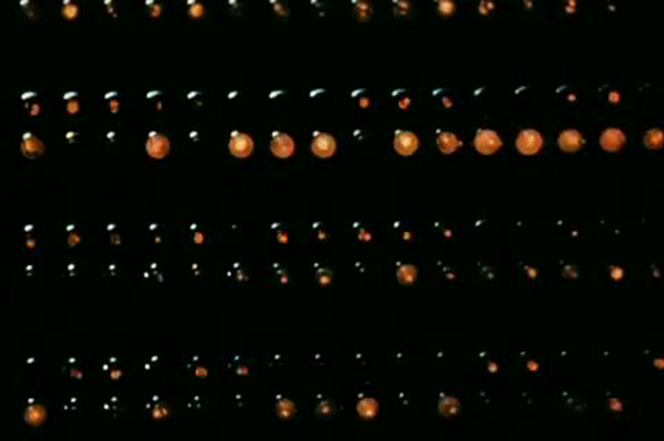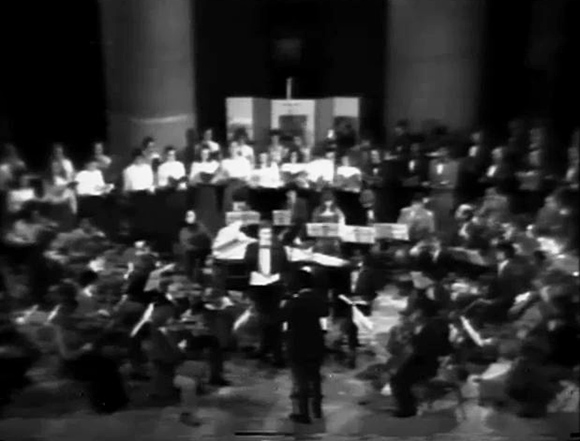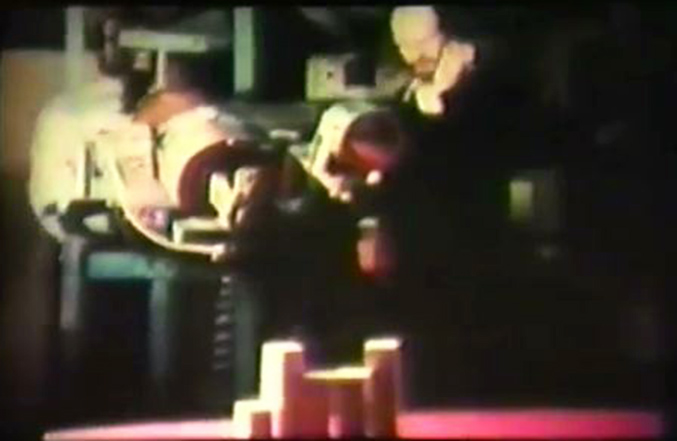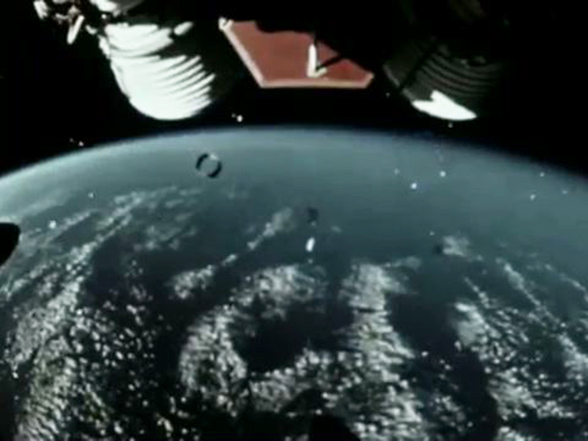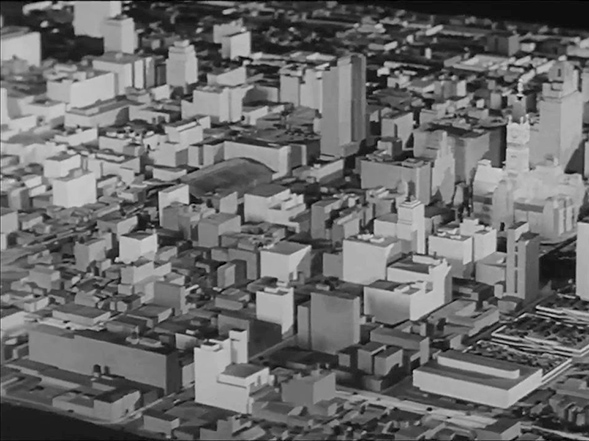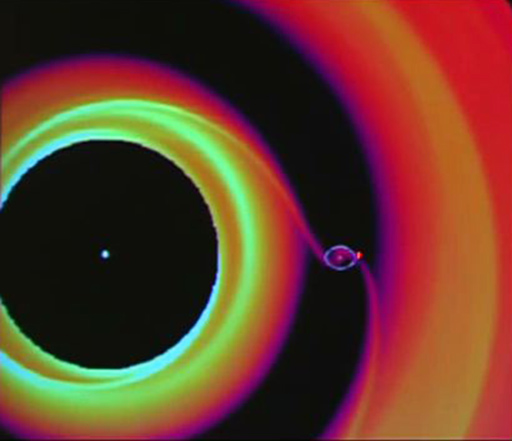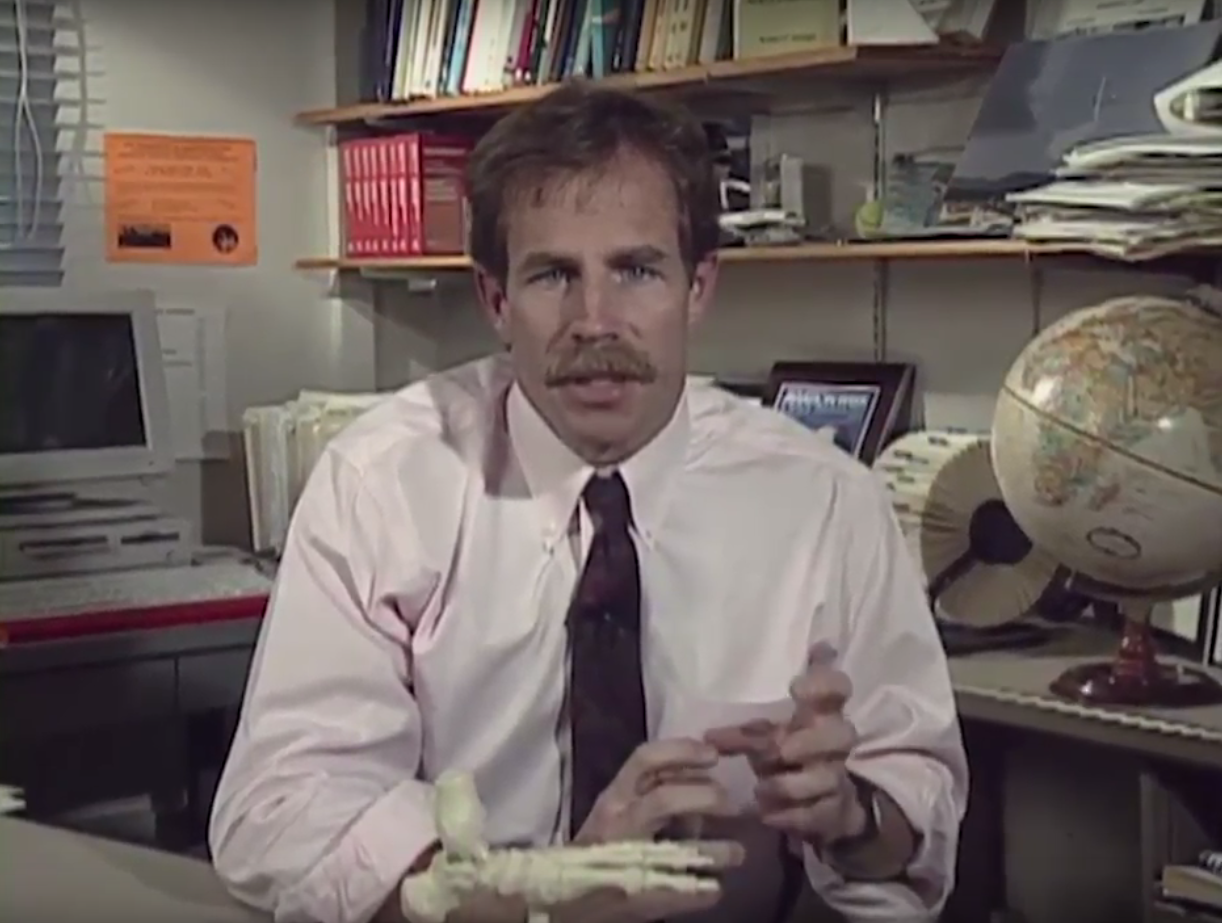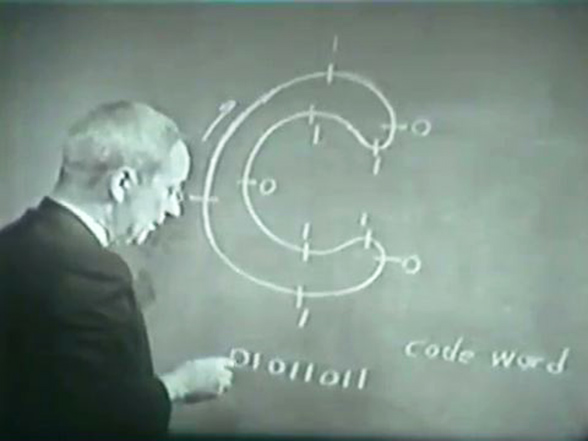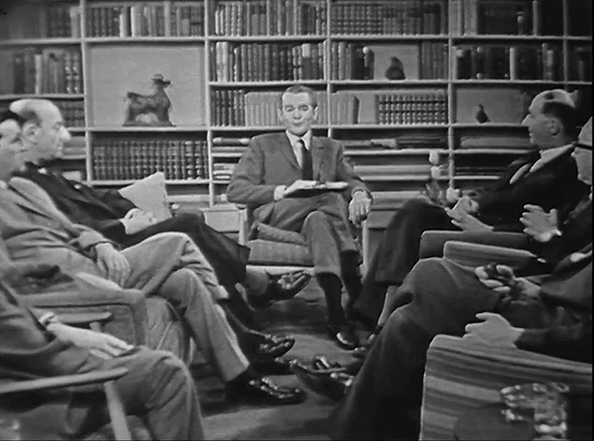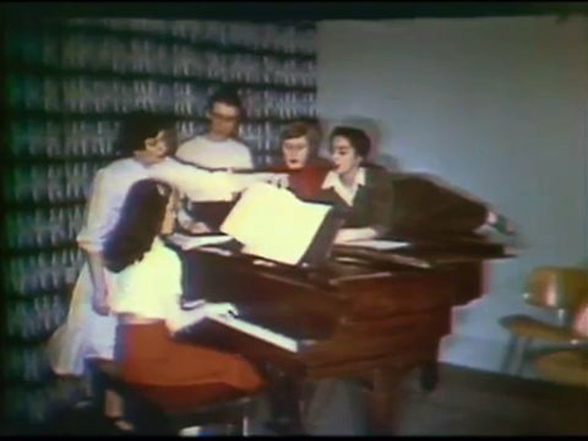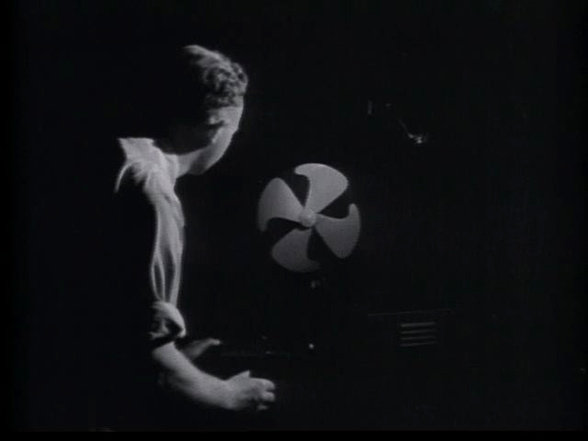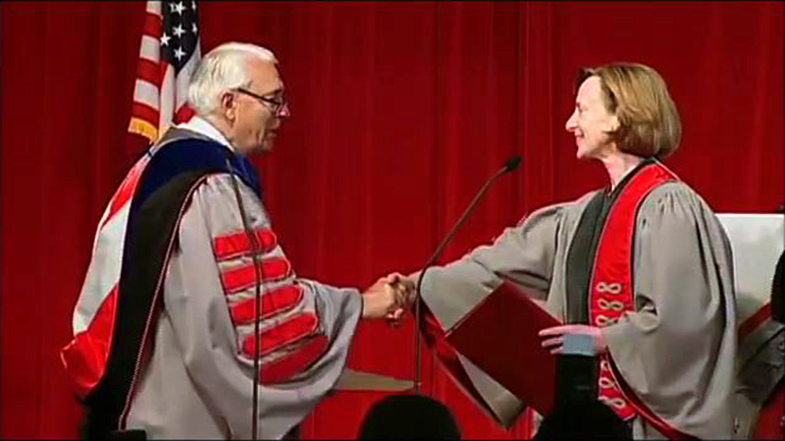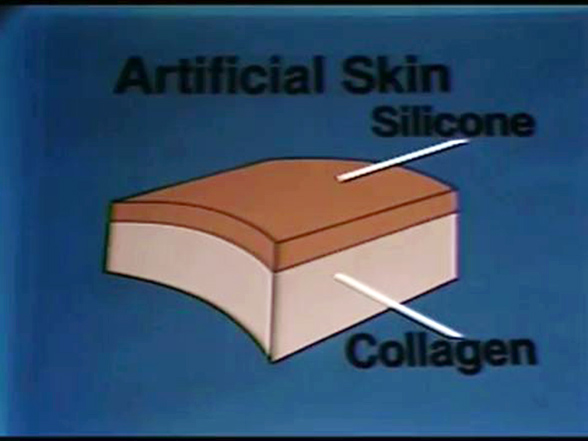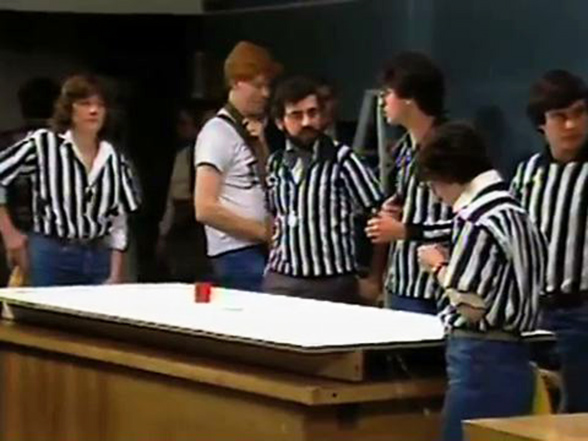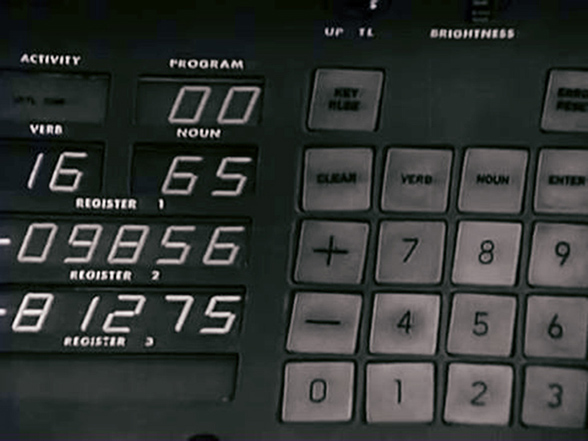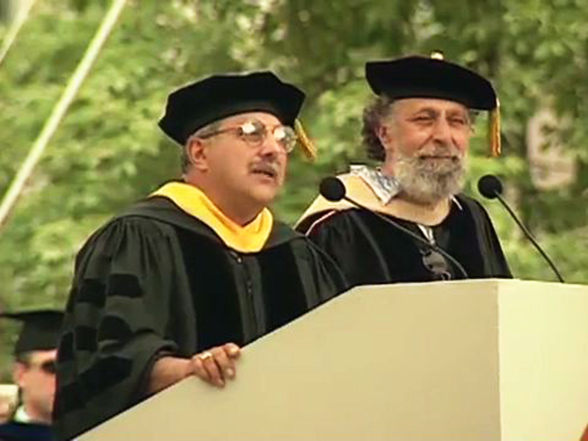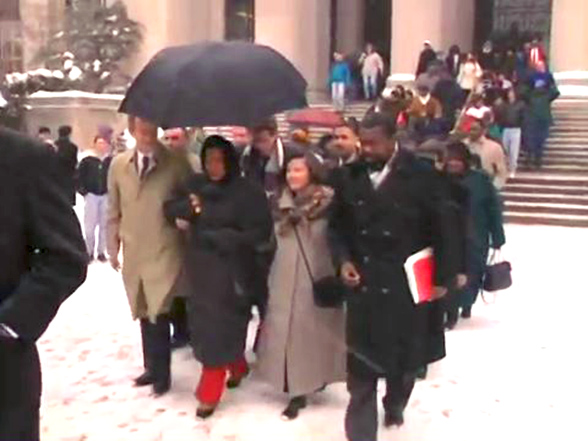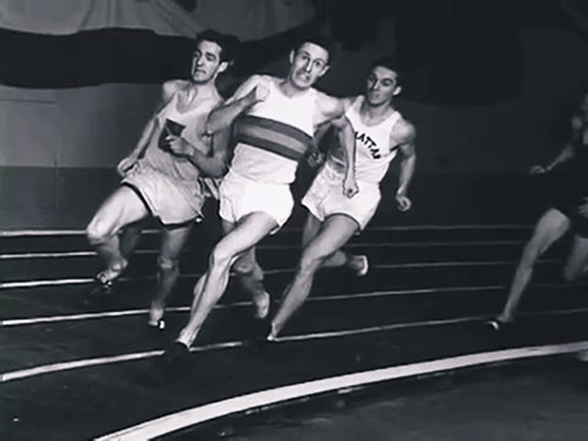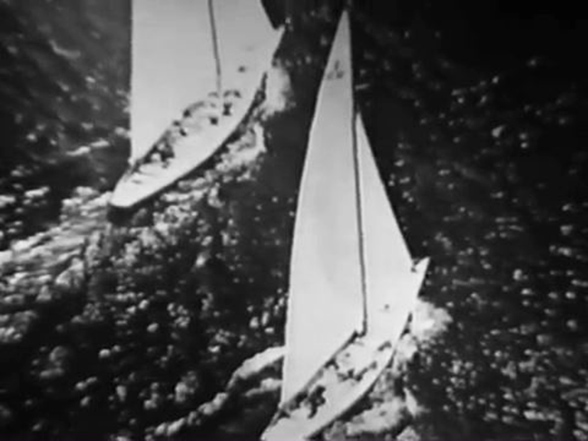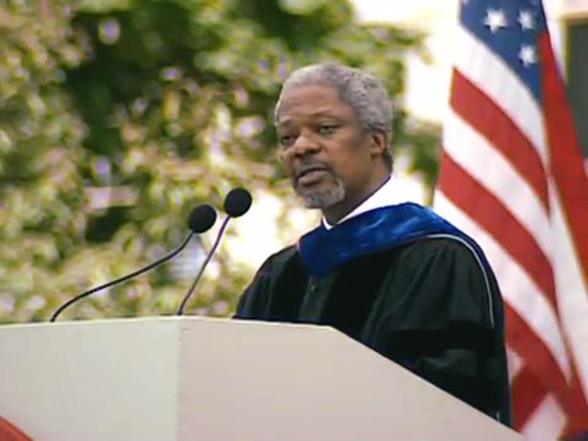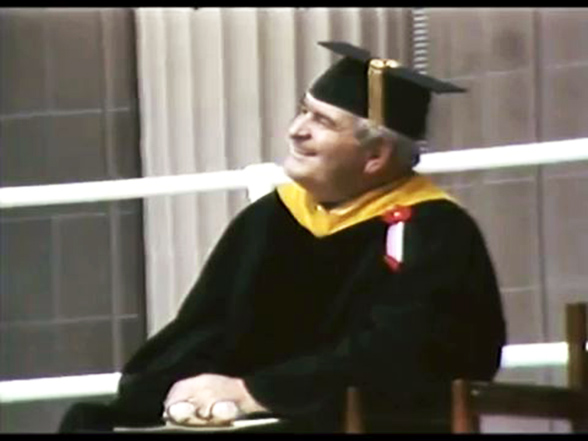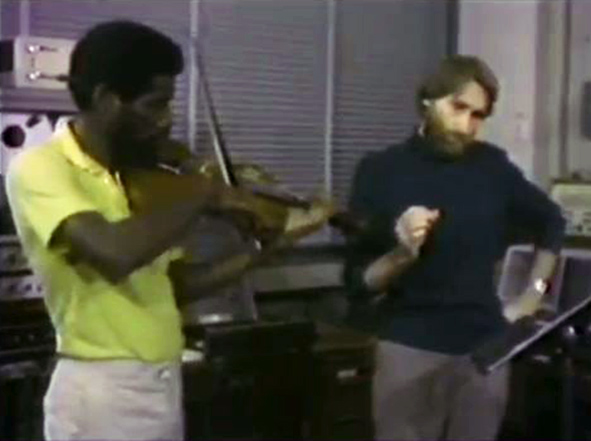MIT Science Reporter—"Underwater Photography"
INTERVIEWER: You are watching a swimmer taking pictures with an underwater camera. But below a few hundred feet, as the light disappears and the pressure has become too great for human endurance, other techniques for photographing the silent world of the deep oceans have to be used. These techniques for deep-sea photography are our story today on Science Reporter.
[MUSIC PLAYING]
Hello, I'm John Fitch, MIT science reporter. We're at the MIT swimming pool today to talk to a man who has made major contributions to the science of photography. He is Dr. Harold Edgerton, a professor of electrical measurements in the Department of Electrical Engineering at MIT, a man who is both an inventor and a teacher, and internationally famous as the father of modern high-speed photography.
At the age of 28, Dr. Edgerton invented an electronic device which allowed invisible motion much too fast for the human eye to see, such as the swing of a golf club or the path of a bullet in flight, to be frozen onto a single photographic plate.
More recently, Dr. Edgerton has been adapting his electronic flash lamps to photograph another world which is invisible to the naked eye, the world of the ocean depths. Some of the equipment, designed by Doctor Edgerton for deep-sea photography, is set up here at the swimming pool, and we're going to meet Dr. Edgerton, and learn more about it.
Everything work all right?
MAN: Yeah, everything. [INAUDIBLE]
EDGERTON: Fine, then we'll have it covered from several angles.
MAN: Good.
INTERVIEWER: Doctor Edgerton, that looks very much like an ordinary camera. What keeps the water out, and from ruining the film?
EDGERTON: Well, this camera is like an ordinary camera, except the case acts as a waterproof case. It was developed in France by Captain Jacques Cousteau, whom I met many times. It's now made in Japan. This big lens, for example, comes out. And the lens is protected by rubber rings, called O-rings. Which seal against a surface.
INTERVIEWER: Very nice. Now, how do you focus, and set the distance and the aperture, and all those things?
EDGERTON: Well, you turn those knobs. And you'll see one of them changes focus, and the other one changes the aperture.
INTERVIEWER: Oh, yeah. That's very clever.
EDGERTON: And this fits in through the O-rings, and that seals. Now, I'm not going to take this apart, because it has this film in here.
INTERVIEWER: Right.
EDGERTON: But if you pull these two levers, the entire mechanism-- the camera mechanism-- comes out, and you can get at the film.
INTERVIEWER: And it's also sealed in?
EDGERTON: It's also sealed in, and you trigger the thing by means of a pusher, at this point. Release.
INTERVIEWER: And I noticed he also took his own light along with him.
EDGERTON: Yes, of course. Every picture must have light, and, in underwater, it's particularly important, because sunlight does not penetrate too well. And you always want to fill in shadows. And, of course, in this day and age, color is important. And when you shoot color, the absorption in the water of about 10 feet kills most of the red. So the pictures will be blue or green, and they're very unsatisfactory.
Now, by having a lamp close to the subject, on your camera, you tend to get more of the proper color onto the film. Now, also, I'd like to show you a side light, here. Good photography. Would you hold the camera for a moment?
INTERVIEWER: Sure.
EDGERTON: Now, this is a 200 watt second unit. The one you have is only a 50. And this is battery operated. It's quite heavy in the air, but in the water, it weighs nothing.
INTERVIEWER: This would be carried by a separate diver?
EDGERTON: Yes.
INTERVIEWER: I see.
EDGERTON: Another diver holds this at the side, so that you'll get good lighting on the subject. Now, there's a photoelectric tube, here.
INTERVIEWER: Oh, yes.
EDGERTON: So that when your light flashes, it will trigger this one. And, that way, you can get synchronization without the necessity of running wires between these two people.
INTERVIEWER: Can we try that?
EDGERTON: Sure, go ahead, pop it.
INTERVIEWER: All right. I'll try not to blind you, here. Oh, yes. That one went off at the same time mine did.
EDGERTON: Yeah, and you can have as many of these lights as you wish Of course, each one will require a separate diver.
INTERVIEWER: Now, how far down can you take pictures, with a rig like this?
EDGERTON: This one is tested for 300 feet.
INTERVIEWER: Is that about as far as people can go down in aqualungs or diving suits?
EDGERTON: Well, it's pretty close to the limit. They can go further, but it's quite a feat, and most of the work will be done in that range.
INTERVIEWER: But, actually, 300 feet is only sort of scratching the surface of the ocean, isn't it?
EDGERTON: Yes, indeed. It's just barely getting below. Because the deepest ocean is about seven miles deep.
INTERVIEWER: So what do you have to do, to take pictures at those depths?
EDGERTON: The problems are all exactly the same. You have to have a case which keeps the salt water out. You have to have a window. And you have to have electrical connections, so that you can operate the lamp, and, of course, the camera. Likewise, it has to be protected from these tremendous pressures.
Incidentally, the pressure at the deepest ocean is 17,000 pounds per square inch. More than eight tons on every square inch will be pressing to push it, to push the case in.
INTERVIEWER: Well, then, do you have cables that run down from the surface to turn on the lamp, and click the shutter, and advance the film?
EDGERTON: Well, on the usual ship, there is a cable without wires, and is the cable you'd like to work on. So most of the equipment that we design has batteries in it and automatic gear, so that it runs without the necessity of any electric connection to the surface. That's the way in which it's done on most of the ships, at the present time.
INTERVIEWER: Well, could we actually take a look at some of the equipment that you've developed to solve some of these problems?
EDGERTON: Yes, indeed. I'd be delighted. We have one in the pool, here. And I'd like to have some help pulling it out, and I'd like to show you the various components of this unit. How about some help, boys? Let's get this out of the water.
Well, the camera's coming up now. This weighs about 300 pounds in the air, so it's quite a heavy assembly, with these big steel cases.
INTERVIEWER: You wouldn't actually use ropes like that in the ocean, would you?
EDGERTON: No, we use heavy steel cables.
INTERVIEWER: That's quite a rig.
EDGERTON: Now, relax-- slack off a little bit on the block and tackle. Let's move it over this way so that we can see it a little better, and put it on the flat part of the deck. Now, the cameras are on this end, John. These are the watertight plugs which bring in the electrical power from the battery, which is down in the strobe. And the other wire carries a synchronizer connection for operating the shutter.
INTERVIEWER: At the same time that the light goes off?
EDGERTON: When the shutter operates, here, it close a circuit which flashes the strobe. There are two of these cameras, so that you can get stereo. Stereo pictures. Now, the clamp here does not need to be strong, because the pressure of the sea holds it down against the other part.
But the back part of this camera has to be very thick and heavy. You'll notice that's hardened steel, about an inch thick.
INTERVIEWER: Really, the pressures are that great, that you need a steel like that?
EDGERTON: Eight tons per square inch is very serious pressure. Now here, again, is the O-ring, which seals against the steel of the camera portion. Now, you'll notice a lot of instruments on the back side of this plate. This is a clock which is photographed on the film, between the pictures, which shows the exact instant that the pictures were taken.
This is a pressure gauge. The ocean is open in the back, and when this pressure comes on, it indicates so that the pictures show the exact depth at which the pictures are taken.
INTERVIEWER: I see. When you say it's open to the back, it's only open to the back of the meter.
EDGERTON: Well, it comes in through this little hole in the backside.
INTERVIEWER: Right, just to the meter itself.
EDGERTON: Yes.
INTERVIEWER: Well, that would seem to be-- these are up at this end. Is the camera pointing upwards?
EDGERTON: No. The camera looks the other way, but the film threads around through the back, and we take another picture on a film 19 frames away, which puts all this information. Now, you'll also notice a card. It's very important that these films not be mixed up.
INTERVIEWER: Right.
EDGERTON: So this contains the information concerning the date, which ship the pictures were taken from, the longitude, two latitude, remarks of the crew, and any other pertinent information. And as long as that film is intact, these images will be developed, and a permanent part of the series of pictures.
This camera, incidentally, takes 500 pictures on a 100-foot roll. I'll now pull out the camera. You'll notice everything is put into a cylindrical form, so that we can withstand the tremendous pressures.
So the lens is on the front, and looks through a window at the bottom. The window is one inch thick of hardened glass, to withstand the pressure. There's an O-ring which seals it, so that the water will not come in. This lens is a special one, developed out at the University of Rochester by a President Hopkins.
INTERVIEWER: Why do you need a special lens?
EDGERTON: Because when you go through the glass into the water, you get some aberrations, and the pictures are not as clear as they should be. so by having a corrected lens, we can get a picture that's clearer over the entire surface. And that way, you can get more information on the same film.
The reel, it's a standard reel of 35 millimeter film, which leads through a gate, through a metering mechanism, through the other lens and gate-- we're putting on the data, on the back.
INTERVIEWER: Oh, that's where this was.
EDGERTON: That comes on the back, yes. And, later on, we'll look at some of these pictures showing these parts. On the backside of the camera, everything is open. All the wires are readily accessible. So it's easy to check this thing, and see if it's going, and make it work.
INTERVIEWER: Now, there would be the electronics for operating the shutter, and for rolling the film, and things like that?
EDGERTON: Yes. I'll put this back in.
INTERVIEWER: I'm really impressed at the thickness of all of this. I suppose you really need that.
EDGERTON: Now, be careful. Don't bend that.
INTERVIEWER: Hey, I better let you put that back.
EDGERTON: Thank you. Well, you'll notice the wall is about 3/8 of an inch thick, and this is hardened steel. And the pressure of the sea is, of course, trying to crush this. I brought in a the casing which didn't make it. I thought you would like to see this.
INTERVIEWER: This used to be a camera case?
EDGERTON: Yes, this is a camera case. The steel was not up to specifications, and this failed about four miles deep.
INTERVIEWER: Isn't that incredible?
EDGERTON: Yes, the forces are--
INTERVIEWER: Really clearly squashed that one.
EDGERTON: --are very, very considerable. Now, the other end contains the control mechanism.
INTERVIEWER: Okay, we don't we take a look at that?
EDGERTON: The strobe is in this case. There's a battery in here, which has enough energy to take about 1,000 pictures. We only take 500, and we have a spare capacity, there.
INTERVIEWER: Actually, you're only using the light while you're taking a picture, so this is probably as efficient a means as you possibly could have for illuminating the scene.
EDGERTON: Yes, this is the most efficient method. Here, again, is the back plate, which now serves only to bring out the wires. And if you look closely, I think you can see this clock. This is an automatic clock.
INTERVIEWER: What's the purpose of that?
EDGERTON: That's to give you delay. Because when you're working five or six miles deep in the ocean, it takes about two hours in order to lower this down to the bottom of the sea.
INTERVIEWER: And you don't want to start taking pictures all the way down through miles of water. You'd run out of film before you got to the bottom.
EDGERTON: That's right. So you set in a desired time, usually about two hours. And you make a note, put your battery in the thing, put it together, put on the cover. And it's quite important to test it, to be sure that everything is working.
INTERVIEWER: Now, has this rig actually been used in taking deep-sea photographs?
EDGERTON: No, this is the deepest that this camera's been.
INTERVIEWER: Here in the swimming pool?
EDGERTON: It's a brand new one, and it hasn't been tried. But I would like, very much, to show you some movies of an actual camera rig. Larger than this, but built of the same components, as used on the Atlantis. So let's look at those pictures now.
John, you're seeing some pictures taken by Sam Raymond on the Atlantis II, last spring, when they went out to make a photographic effort at the sight of the thresher disaster.
INTERVIEWER: Who did the Atlantis belong to?
EDGERTON: Atlantis II is the latest oceanographic ship of the Woods Hole Oceanographic Institution. You see camera gear on the deck, here. That was taken to the site. There were two complete equipments available, so that one could be serviced while the other one was down at the bottom of the sea, doing its work.
Alex Johnson. Woods Hole is there. Dr. [? Herzey's ?] just come into the picture. It takes six men to roll "Big Jenny," as they call her.
INTERVIEWER: I see. That's got a lot more equipment on than the one we've been looking at.
EDGERTON: Yes, this has four times the light capacity, and it also has an extra camera, there. And you'll notice that the rig is bigger.
INTERVIEWER: It seems to be tilted, too.
EDGERTON: Yes, it's tilted, so that the lamps will be closer to the bottom. This equipment was designed to work from 30 to 40 feet from the bottom, in order to cover more area. The ship was allowed to drift very slowly, so that overlapping pictures could be obtained of an area about a quarter, possibly a mile long. Continuous coverage of everything on the bottom, with a strip, possibly, 20 feet wide.
The camera's now on it's way down. As I mentioned, it takes about two hours, the deepest ocean. I think it took them about half an hour for the gear to get to the bottom. Here, the winch operator is watching the lowering of the camera.
INTERVIEWER: The cable wound on that peculiar drum?
EDGERTON: This is one of the sonar devices that's used off the end of the ship, for reading the bottom. Now, you see a map of the trail of these cameras, as they went over the bottom. They made many lowerings. And, quite often, the camera would be a mile away from the ship, because of the currents that are exhibited in the area.
And it's quite a technical problem to determine exactly where the camera is, but Woods Hole did this, made these charts, and, in this way, they have a coverage of the area. Now the camera's come up from the bottom. The film has been exposed, and the next problem is to get this big, heavy thing over the side of the ship.
INTERVIEWER: I think that would be very difficult, if the seas were at all rough.
EDGERTON: Yes, indeed. It gives the equipment a good shock test. Quite a few of these cameras are lost at sea, due to various accidents occurring, and breaking the cables, and camera's get caught on something, or the rigging of the ship fails. And, frankly, every ocean in the world has one of these cameras at the bottom.
I [INAUDIBLE] put my name and address on once, so that I go out to sea with the hopes that they'll be found, but I realize it's a great-- [INAUDIBLE] and there, you saw a flash. The batteries still have energy in them, and they keep running, although the film is run through completely.
The next thing, of course, is to find out if there's anything on the pictures. And the Atlantis, too, has a continuous processing machine on board.
INTERVIEWER: So the [INAUDIBLE] actually develop the film right at sea?
EDGERTON: Yes, as soon as the pictures are up, and the camera's-- the cameras, when they come up, are cold, and we pour hot water on them to warm them up, otherwise the moisture will condense on the inside. Then, the films are taken out, rushed into this machine, and put through. And, also, prints are made.
So you can see the data chamber on the side, which has the full information on where that picture was made, and when it was made, and what it was about. On some of these pictures, you can see fragments, which are things that, presumably, came out of the ill-fated thresher.
INTERVIEWER: Well, Dr. Edgerton, when you want to take pictures of the very bottom of the ocean, do you just lower this whole cage right down to the bottom, and then lift it off a little ways?
EDGERTON: No, you'd be in trouble if you did that, because the camera would go into the mud or hit some rocks, and it might get caught. What you do, John, is to lower this on a heavy cable, say, 5 miles deep, and then stop it when it's 20 feet off the bottom.
INTERVIEWER: Sounds like a pretty difficult trick.
EDGERTON: Yes, it is. The Cable length is quite often considerably longer than the distance to the bottom, due to the fact the camera is blown sideways by currents and tides. So it's very essential that we get a measurement from the camera through the bottom. And this is accomplished by means of an instrument called the pinger, which I would like to show you.
This device in the center, here, is a sonar transducer that sends out pulses of sound at one second intervals. The pulses last about one 5,000th of a second. It's a 12 kilocycle frequency.
INTERVIEWER: So you can actually hear it, then?
EDGERTON: You can hear it as little pings.
INTERVIEWER: That's where it's the name.
EDGERTON: That's where the name. Now, the way in which it functions is the following. As the camera approaches the bottom, these sound pulses come directly from the transducer to the ship. But there's also another sound that goes from the pinger to the bottom, and up to the ship.
So if you hang a hydrophone in the water, you hear first the direct ping, and then the reflected ping. This chart, I think, will make it clear. The camera, with the pinger, is approaching the bottom.
The direct sound goes directly to the ship and is recorded. The other goes down to the bottom, and then to the ship. And you'll notice this distance is longer, so that the reflected ping will arrive at a later time.
INTERVIEWER: Now, when you say later, how much later, when you're down near the bottom?
EDGERTON: Two thousandth's of a second will tell you when the camera's 10 or 20 feet off the bottom.
INTERVIEWER: How can you possibly hear the difference in time of a few thousandths of a second?
EDGERTON: Well, the ear is not that good. So, instead, we use a recorder on the ship, a sonar recorder, which puts all this information onto a tape. One of there recorders is shown here.
Now, to demonstrate this, we have taken the transmitter and put it on the edge of the pool, so that it emits sound towards the far end of the pool, which is about 75 feet away. And when the sound is reflected, and comes back from the other side of the pool, we get a strong signal.
INTERVIEWER: Now, which way is the sound going?
EDGERTON: This is where the sound starts. These timing marks are about 24 feet, represented by 24 feet. So you can see the pool is about 75 feet long.
INTERVIEWER: Well, all of this hash over here is the end of the pool?
EDGERTON: This is the reflection from the end of the pool, and we get little side echoes, there, from the other portions, which are a little bit further. So we get a depth. And this noise that we see, the noise that we see part way to the end, is from a shallow part. We're transmitting in the deep part, so there is a shoulder, there, which gives us a signal.
Now, this is coming through very slowly. It's transmitting all right. And, now, we've asked Stewie to jump into the pool, and to swim slowly towards us with a stroke which will make many bubbles, because sound is reflected by these bubbles. OK, Stu, jump in.
INTERVIEWER: And we should see the reflections off of the bubbles as he comes closer to us?
EDGERTON: Yes. As he comes closer, these signals will be reflected and recorded. And then, at the end, when he reaches the end, here, we'll pull this out, so that we can see it on the tape. Each time he makes one of these splashes, he makes a lot of bubbles. I think you can hear him coming, now.
INTERVIEWER: He'll get us all wet, too.
EDGERTON: Well, I can see he made a big blob, there, at the beginning, and he's on his way. Now, when we use this with the cameras, we run it a little slower. But, essentially, we'll have two records that come to tell us the height and width.
We're going to get wet, here, in a minute if we don't watch out. He's too vigorous. Thanks a lot, Stu.
INTERVIEWER: Then we pull this out?
EDGERTON: I'll pull this record out. Here's where Mr. Nelson jumped into the pool. The slope of this line is proportional to the velocity which he came down to this end. And each stroke can actually be seen on this record.
INTERVIEWER: Now, this brings up a point. If you can sit at this end of the pool, and sort of follow an object that's at various distances away from you, and also see the bottom at the same time, then why couldn't you have your pinger on board the ship, and follow your camera as it went down towards the bottom, and thereby measure the difference? Why do you put the pinger right on the cage?
EDGERTON: That's a good question, because when we first started working in underwater photography, that's the way we did it. But we were only working down to about 1,000 feet. This mechanism that we just examined, this deep-sea camera, can be seen on most ships down to about 1,000 feet. But deeper than that, it becomes too weak a signal, and cannot be seen.
INTERVIEWER: So it's too small a target?
EDGERTON: Too small a target. So, instead, we make it a source of sound, and then we can see it very clearly at these great depths. Also, it begins to be dim, even then, at five miles. This signal is quite weak, and it will be lost on a normal oscilloscope because of the various noises that you get from the sea.
But by having a recorder that puts all the information down into a visual form, then you can still see through this noise. And you can pick up these very faint little dots, and they can give you the information that you wish.
INTERVIEWER: Even though it's five miles away from you, and you're talking about measuring a few feet.
EDGERTON: That's right.
INTERVIEWER: I wonder if we could actually see some of the photographs that have been taken at these tremendous depths.
EDGERTON: Certainly. I'm delighted to show you some of them.
John, I have a few pictures here I would like to show you. The first one shows a place in [? Romaine's ?] trench, taken by some of the Woods Hole group.
INTERVIEWER: Looks mostly like mud.
EDGERTON: You're right, absolutely right. But if you look closely, you can see some small animals. Many of the pictures we take in the sea are mud, and, of course, that's what we go out to find, what is there. Now, other places you'll find rocks, and here's some rocks. And here's a sample of one of these rocks glued onto one of the underwater camera window.
INTERVIEWER: Oh, I see. You actually dredged that one out?
EDGERTON: Yes, that dredged raised up. There was a pinger on the dredge so that we knew when the dredge was on the bottom. And that made a good Christmas present for my wife. There are other kind of rocks. This is a very famous picture taken by Dave Owens at Woods Hole in one of Dr. Ewing's early cameras. It shows nodules at a great depth, many years ago. Here's another picture.
INTERVIEWER: Sometimes you're lucky, and you catch a fish.
EDGERTON: Yes. This is interesting to me, because the biologist on this expedition said, there's no use taking pictures here. There are no fishes in this area. And here's starfish. These starfish are on the bottom.
INTERVIEWER: Oh, that's beautiful.
EDGERTON: And here's some very beautiful animals. You can see that the currents are affecting these animals. This was taken by Dr. Richard Pratt.
INTERVIEWER: Sort of a sea anemone, or something like that?
EDGERTON: I think that's what you call it.
INTERVIEWER: Very interesting. Well, it certainly shows a valuable the pinger is, in positioning yourself precisely so far off the bottom, so you have a perfect picture, like that.
EDGERTON: Yes, indeed. And I think you'd be interested in knowing that, with the pinger, we also have the ability to penetrate below the bottom. Here's the Boston Harbor. The surface, the bottom of the harbor, and if you look closely, you'll see some hemispherical signals, down at the bottom. Those are tunnels that go from Boston to the airport.
INTERVIEWER: Under the harbor?
EDGERTON: Under the harbor.
INTERVIEWER: So the sound actually penetrates down through the mud itself?
EDGERTON: Yes, and we call this machine the Mud Penetrator.
INTERVIEWER: Can you see any deeper than that? Which, I guess, was about, what, 10, 15 feet under?
EDGERTON: Yes, that's about 10 feet. In some places, we can go 50 feet down. And we have hopes of going still further. In some places, it works very well. In other places, we have great difficulty. We're still learning a great deal about this technique. Now, this last picture that I have to show you was taken in the ocean-- deep ocean-- with a very large sound source, which we call a boomer.
INTERVIEWER: Does that indicate a lower sound? A boomer, rather than a ping?
EDGERTON: That's right. A much lower sound, and a much more powerful sound.
INTERVIEWER: So that would penetrate more deeply?
EDGERTON: It penetrates deeper, but it doesn't have the ability to give us a good, sharp resolution. But it does go deep. And this is a side of a volcano that extrudes from the bottom of the sea, out part way from here to Bermuda. This is taken by Dr. [? Herzey ?] on one of the Woods Hole ships, and it shows sediment layers that extend downward to approximately a half a mile below the bottom.
INTERVIEWER: It's all been filled in over the ages.
EDGERTON: That's right. It keeps coming down as time goes on. This particular kind of work is in a very active stage, right now. And all of the oceanographers in the world are trying to make louder noises, and lower frequency noises, and better recorders to get deeper and deeper into the earth.
INTERVIEWER: Well now, is there any way that you could cover a greater area, so that you could see more of this underwater bottom area?
EDGERTON: Yes. These records can be put together. You'll notice on the wall, here's a record of the Puerto Rican trench which was sent to me by Dr. [? Herzey ?] of Woods Hole. It shows the sediment ponds at the bottom, and it shows the layering and the sediments on the sides of this very interesting place.
INTERVIEWER: Well, thank you very much, Dr. Edgerton. Today, our story has taken us to the swimming pool at MIT, to learn more about underwater photography and underwater sound. Our guest has been Dr. Harold Edgerton, professor of electrical measurements in the Department of Electrical Engineering. I'm John Fitch, MIT science reporter.
[MUSIC PLAYING]
This is NET, National Educational Television.
